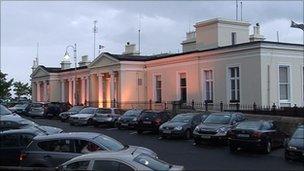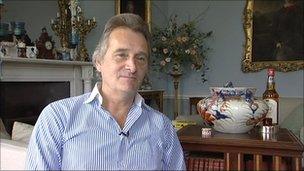Queen's visit to Ireland: the Royal legacy
- Published

Royal St George Yacht Club in Dun Laoghaire, formerly called Kingstown
Before the sun set on British rule, the port constituency of Dun Laoghaire was the most loyal in what is now the Republic of Ireland.
Those who had the vote - and not everyone did - regularly returned unionist MPs and the area was once renamed Kingstown in memory of a royal visit.
There are still monuments, topped with a crown and some relatively recently restored, that commemorate the old links to the British monarch.
The RNLI, for example, is also part of the British legacy.
'Times have changed'
Few in the Republic may know that the "R" stands for royal but the word is not a concern for the Royal St George Yacht Club in the heart of Dun Laoghaire.
A century ago, the congregation at the Church of Ireland church in the nearby Monkstown area would have been enthusiastic unionists, fervent in their support for the crown and the British link.
But, according to the local rector, Reverend Canon Patrick Lawrence, times have changed.
"We just see ourselves as Irish. We see ourselves as members of the Church of Ireland, founded by St Patrick in 432 AD," he said.
"And that's how we see ourselves in modern Ireland today - with a regard, of course, for the traditons that have made us what we are with that influence from our English neighbours."
There is respect among the congregation for the Queen, not least for her role in their Anglican sister church, the Church of England.
But worshippers stress that doesn't make them in any way British.
"I am 100% an Irish woman and very proud to be Irish", one member said.
Another told me: "I feel completely 100% Irish and I've always been brought up like that. My father was very nationalistic, even though he was a Church of Ireland rector."
'West Brit'
Those views cross the age divide.
An elderly lady said: "The head of our church is the Archbishop of Armagh.
"We feel we have nothing to do with England now. And the Queen to me is the head of our neighbouring country."

Marquis Conyngham is proud to his Irish heritage
Thirty miles north is the River Boyne and the picturesque village of Slane.
The castle there and its surrounding lands were a reward to the Conyngham family for their support for King William in the Battle of the Boyne - the river runs through the estate.
Better known as Lord Mountcharles, Henry, the current Marquis Conyngham, has no doubt about his Irish nationality, even though his is a British peerage.
He says that when he went to Harrow public school in England he was nick-named "boggy" because of his Irish background.
Then when he returned to Ireland after Harvard in the United States and working in London he was described by some as a "West Brit".
"I was born in Dublin. I was brought up in Slane in County Meath," he said.
"This is my country and I feel very passionately about it."
The Battle of the Boyne Visitor Centre near Drogheda is further up river from Slane.
Open to all, it's a place where schoolchildren can learn about the different traditions on the island.
One of those traditions, the Orange Order, has said only a small number of Protestants south of the border are members.
Some of those that are were reluctant to speak on he record but said they regard themselves as both British and Irish and want, regardless of strict legal entitlement, access to British passports.
Whatever their sense of nationality, nearly all Protestants in the Republic welcome next week's royal visit.
- Published12 May 2011
- Published11 May 2011
- Published4 May 2011
- Published16 March 2011
- Published4 March 2011